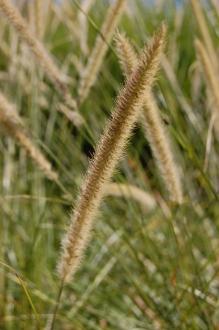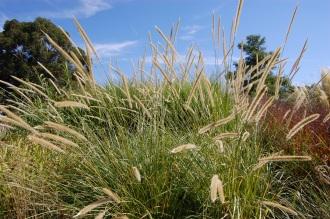
Pennisetum macrourum Flower (08/09/2012, Kew Garden, London)
Position: Full sun
Flowering period: Late summer to early autumn
Soil: Moist, well drained
Eventual Height: up to 1.8m
Eventual Spread: 90cm
Hardiness: 9a – 10b
Family: Poaceae
Pennisetum macrourum is an erect, deciduous clump forming grass. Its mid green leaves are linear with entire margins, up to 1.2m long and 12mm wide. Its leaves turn yellow in autumn. Its light brown flowers are in the form of cylindrical panicles and are up to 30cm long. Its roots are deep and rhizomes which aids its spread.
Pennisetum macrourum, commonly known as the African Feather Grass, is native to the southern part of the African continent. This plan is considered to be a noxious weed in some parts of the USA and Australia.
The etymology root of the binomial name Pennisetum is derived from the Latin penna ’feather’ and seta ‘bristle’ in reference to the seed heads. Macrourum is derived from the Greek makros meaning ‘long’ and oura meaning ‘tail’, in reference to its flower spikes.
The landscape architect may find Pennisetum macrourum useful as part of a prairie type planting scheme, looking particularly good when planted en mass. Once established this grass is drought tolerant.

Pennisetum macrourum (08/09/2012, Kew Garden, London)
Ecologically, Pennisetum macrourum seed is attractive to some birds.
Pennisetum macrourum prefers moist, fertile, well-drained soils. It tolerates most pH of soil.
Pennisetum macrourum requires little maintenance. To keep a tidy appearance last years leaves may be pruned to ground level in spring.

